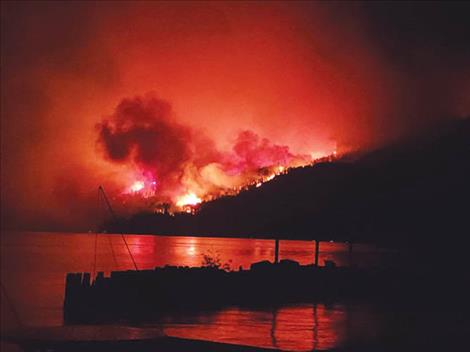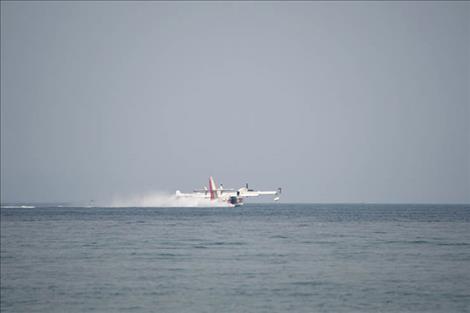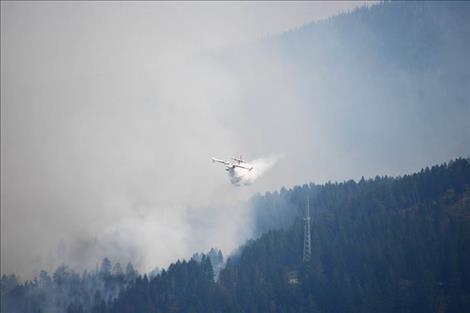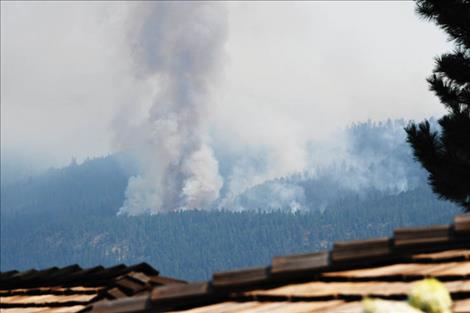Hot summer causes dangerous fire season — with most of August yet to come
Hey savvy news reader! Thanks for choosing local.
You are now reading
1 of 3 free articles.
Firefighters working on the east shore of Flathead Lake thought they had the Boulder 2700 Fire in check as the sun set on Saturday afternoon. The fire started the night before — the cause is unknown but early indications are that it was started by humans — and throughout the day scooper planes hit the blaze with thousands of gallons of water.
Then a warm wind from the north started blowing.
The fire jumped Montana Highway 35 and made a run toward Finley Point, a thin finger of land that curves out into Flathead Lake and is home to a few hundred people. Shortly after midnight on Aug. 1, the Lake County Sheriff’s Office issued a mandatory evacuation for Finley Point and the surrounding area. The fire exploded toward the water’s edge, destroying at least 20 structures on the way and producing a menacing glow that could be seen from Polson until dawn.
“They were doing everything right, and then the winds came,” Confederated Salish and Kootenai Tribes Fire Prevention Specialist and Public Information Officer C.T. Camel said of the firefighters who had worked the fire Saturday afternoon. “I’ve never seen fire behavior like that in these parts, but this summer is different.”
Firefighters say that fires in western Montana rarely flare-up that late at night like Boulder 2700 did this week, but this summer’s extreme heat is pushing the traditional burn period later into the evening. Camel said when the sun set on Saturday, the fire along the east shore was estimated to be about 200 acres. By the following morning, it had grown to more than 1,000 acres. “It was burning like it would in the middle of the day,” he said.
Camel said it was still 90 degrees after midnight along Flathead Lake, which helped fuel the fire, along with a downslope wind coming off the Mission Mountains. Extremely warm days and unusually warm nights helped raise the daily average temperature significantly, said meteorologist Travis Booth with the National Weather Service in Missoula. About 40 miles north of Finley Point, in Kalispell, the average daily temperature was 71.5 degrees, 6.6 degrees above normal, making it the second warmest July there since the weather service started keeping records in 1899 (the warmest July was in 2007).
Until this week, Northwest Montana had received a scant amount of rain this summer. According to Booth, the Kalispell area recorded .2 inches of precipitation in the month of July, a full inch below normal. Due to dry conditions, nearly half of the state is under Stage 2 fire restrictions, which restricts the use of machinery to certain times of the day and prohibits campfires and smoking outside.
On Monday, the state launched a new website to share information about current fires called mtfireinfo.org. According to the state, more than 480,000 acres have burned this year, exceeding the annual average from the last decade, with nearly two months left in the traditional fire season. The state’s biggest fire year in more than a century came in 2017, when more than 1.2 million acres burned.
After weeks of dry weather, some rain did fall across northwest Montana this week, which bought firefighters more time to build containment lines around the Boulder 2700 Fire and others burning near Arlee, Troy, Thompson Falls and elsewhere. Lincoln Chute, fire service area manager for Flathead County, said his biggest concern this week was that the little rain that did fall will leave people with the impression that it’s ok to have campfires or park in tall grass again. He said what little precipitation that fell can dry up in a matter of hours.
“We can’t take our eye off the ball just because we got a little rain,” he said.
Chute was working a fire near Polebridge when the fire erupted on Flathead Lake but he said from the images and video he had viewed, the Boulder 2700 Fire was displaying fire behavior normally seen in California, not Montana.
But one firefighter said what was seen on Flathead Lake this weekend wasn’t unheard of; one just has to look at history. Rick Trembath has been fighting fires in northwest Montana for more than 50 years and was a member of the elite Flathead hotshots back in the 1960s. He’s also a student of fire history. Trembath said there have been other big fires that roared through the night in these parts, specifically in 1910 and 1929.
The Great Fire of 1910, also known as the “Big Burn,” torched 3 million acres in two days across eastern Washington, north Idaho and western Montana, leveling entire towns and killing at least 87 people. The summer of 1929 was another bad one for fire, specifically in the Flathead Valley, where the Halfmoon Fire torched more than 100,000 acres and crossed three mountain ranges and a river in just two days. Trembath said that incident helped build a healthy respect for fire among the locals that lasted generations, but today most people have not seen fires like that.
Both the Great Fire of 1910 and the Halfmoon Fire were started in mid-August, traditionally the busiest part of the fire season in western Montana. And that’s what worries people like Chute.
“We’re just at the beginning of this thing,” he said. “That’s the scary part.”
Justin Franz is a freelance writer, photographer and editor based in Whitefish. Originally from Maine, he is a graduate of the University of Montana’s School of Journalism and worked for the Flathead Beacon for nine years. His work has appeared in the Washington Post, Seattle Times and New York Times. Find him at justinfranz.com or follow him on Twitter.



















